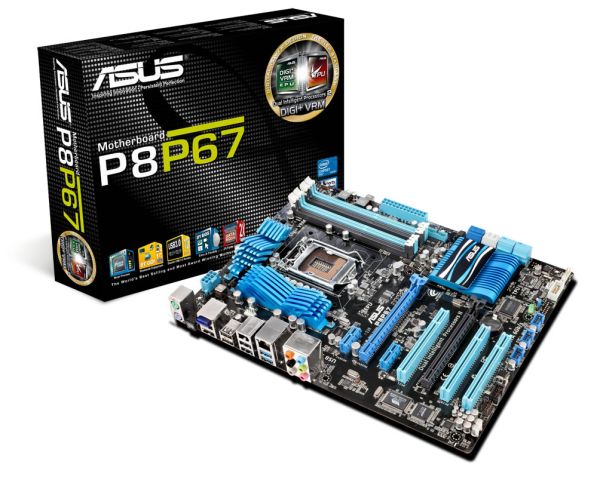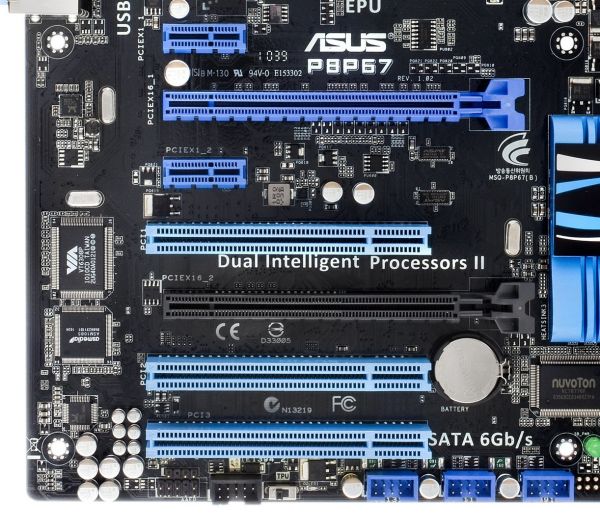ASUS P8P67 Review
by Brendan van Varik on September 8, 2011 10:45 AM EST- Posted in
- Asus
- Motherboards
- P67
Today, we will be looking at the ASUS P8P67. Although the board has been available for some time, this is one of ASUS' cheaper full size ATX offerings. Considering it has a price tag of $155 ($140 with rebate), it offers quite a few useful features such as DIGI+ VRM, BT GO! (Bluetooth), a total of four USB 3.0 ports, and Quad-GPU CrossFireX support.
Even though the P8P67 does not offer as many features as the more expensive models in this range, or even some of the optional extras in the box which other boards come with in the same price range, it does perform better than you may have initially thought. The biggest complaint we have is the second PCIe x16 slot only operates in x4 mode, which does impact multi-GPU performance. The board's power consumption is also higher than other motherboards we have tested. Overall, I would say this motherboard is a good contender in the sub $160 price range but some of the additional extras which come with the ASRock P67 Extreme4 for example may be enough to sway people towards that board instead.
Visual Inspection
ASUS has decided to go with a blue and black color scheme, which is built upon a black PCB. The black and blue theme carries its way throughout the motherboard on to the expansion slots, RAM slots and the heat sinks as well.
Just like all of the latest ASUS range, their latest TPU (TurboV Processing Unit) and EPU (Energy Processing Unit) processors are on this motherboard. The EPU chip is designed to analyze the actual CPU loading and dynamically regulate the various system power saving and performance parameters in real time. By doing this, it creates an optimal energy saving configuration. The TPU takes care of the system performance - it automatically raises the systems clocks to provide the extra grunt whenever it is required and it also relieves parts of process-intensive tasks from the CPU.
Just like most motherboard manufacturers of the modern age, ASUS has designed the slot layout fairly well. With a GPU, or even two, you will still have a PCIe x1 slot available. They have also allowed for a two slot gap under the GPU which will allow the top card to breathe a little better when using a dual GPU configuration. Unfortunately, you will only be able to use one PCIe x1 slot when you have a dual slot graphics cards.
The P8P67 has a total of four SATA 6 Gbps connections available; however only two of them allow for a RAID array. The navy blue ports, which are on the Marvell controller, do not have RAID support whereas the gray PCH ports feature RAID 0, 1, 5 and 10. The four light blue ports are SATA 3 Gbps.
There are a total of four fan headers on the P8P67 and they are in what I would consider good locations. The CPU header is located above the socket, toward the top of the motherboard. There is another one labeled PWR_FAN; it is located just above the MemOK! button. To finish it off, there are two case fan connections, one of which is to the left of the CPU socket and the other one is located just above the front panel connections.
The back panel contains two PS/2 connectors, a SPDIF output, a total of six USB 2.0 and two USB 3.0 ports. A Firewire port is included as well as the built-in Bluetooth. To finish off, there is a single gigabit Ethernet port and the typical audio jacks.




















52 Comments
View All Comments
pc_void - Thursday, September 8, 2011 - link
I'm in the middle of rma with a different Asus board atm that has to be counted by [gasp] months.zero2dash - Thursday, September 8, 2011 - link
[shrugs]I bought mine despite all those NewEgg reviews and [H] negativity (although that's primarily towards the Pro) and I've had 0 problems with mine.
Very happily running @ 4.6 with 16GB of ram (ie all dimm slots populated). No problems whatsoever.
Pick a board, there's always a problem here or there, it doesn't matter who the manufacturer is.
re: Asrock - I had an Asrock X58 Extreme die after Folding@home 24/7 for 2 months; after RMA'ing it I bought a Gigabyte and sold the Asrock. First and last time I'll buy an Asrock board.
pc_void - Thursday, September 8, 2011 - link
Btw, Asrock boards are also made where Asus boards are made @ Foxconn - that says quite a lot right there.faizoff - Thursday, September 8, 2011 - link
I have the Pro version of this board which I got for around $140 on a very short and quick sale on Amazon. Having owned this board for more than 5 months now I'm really enjoying it's overclocking performance. At first the board wasn't stable and I guess I tried to do too many things before letting it settle in. I remember many sites, when SB came out, most of the ASUS versions. At the time of my build I initially bought a Gigabyte UD3 board which turned out to be a decent overclocker. I regretted at that time for not getting an Asus board that had glowing reviews and ridiculous overclocking stories.After the board recall, I took that opportunity to turn the Gigabyte board in and switch to an Asus one. I think something may have gone amiss with the B3 stepping version of many P67 boards. I first got the Deluxe version and had to RMA that. From the getgo it would crash and hang, just when going through BIOS options.
Getting this board at first also wasnt smooth sailing. After managing to find a stable mini OC at around 4.0 Ghz, I have now OC'd it to 4.5 while maintaining the same temperatures on Hyper 212+ cooling (mid 30s C at idle and mid 50s C on load) and core voltage at max of 1.384 V.
I'm very happy with the board at the moment 5 months on and hope that it continues this way. I certainly hope to keep this computer for another 4-5 years at least. I went from a system with 2.0 Ghz E4400, 1.5 GB DDR, 128 MB Radeon 9600 XT AGP 8x, 15" monitor @ 1024 x 768 that still works 4 years later.
Upgraded to
Intel i5 2500k OC 4.5 Ghz
G. Skills Ripjaw series 8 GB 1333Mhz DDR3 RAM
Asus P8P67 Pro
Crucial 64GB C300 SSD
XFX 6870 1 GB Radeon HD
Asus 23" monitor @ 1920x1080
Rosewill 630w Single +12 V rail
Corsair 600T case (In the process)
gramboh - Friday, September 9, 2011 - link
Man, that is a serious upgrade, I took pleasure reading your post thinking how awesome it must have been to power that new machine up for so long, must have been mind blowing how much faster it was, especially upgrading from a low res monitor to that, lol.Ratman6161 - Thursday, September 8, 2011 - link
Its pretty well known that increasing bclk doesn't work well with socket 1155. With my Asrock Z68 Pro 3 and 2600K, ANY increase in bclk makes the system unstable. Lucky I have those multipliers to play with.With your max overclock you say: "I was able to successfully boot up at 46x103 which gave me a final clock speed of 4738MHz. The system was nowhere near stable but it would get into Windows and run a few tests before crashing."
I bet if you had backed it off to 46x100 = 4600 you might have gotten it stable and the extra 138 Mhz are rather meaningless anyway. Just a thought.
cactusdog - Thursday, September 8, 2011 - link
I have to agree with the guy about the reviews on here lately... too many smartphone reviews and random stuff most of us arent interested in.jecs - Friday, September 9, 2011 - link
I have this MOBO since day 0 as it was almost the only ASUS option in CompuUSA back in January 8.I am using a 2600K with this and I've been very happy with the performance and stability. Basically 0 fails. Also 98% of the time this machine is isolated from the internet with very specific software and system updates.
Ok, I read about 2 previous reviews about this ASUS MOBO, but my point here is how good it is for 3D applications for the price and all you care is gaming. Great!, no complains just an observation.
Also I am using 2 graphic cards I don't care about the limit in the second card as in my case I am using an entry level Quadro 600 for pro 3D viewport applications and for the 8X I am using a 460 GTX 1GB for a few games and game engines. It works very well for me and also for a new rendering application still in beta called Octane. This is my exclusive 3D machine, but I knew very well what I was going to do with this motherboard.
jecs - Friday, September 9, 2011 - link
As many of you I don't like the direction the computer industry is taking with tablets and smartphones, but I understand for the massive market a desktop PC or even a laptop is not the best option. Ouch, I hope not to see a considerable increase in prices for desktop parts in the next years.I like to think of this as a happy time of coincidence when power users benefited from the growing consumer market needs. But that ship is not with us anymore.
just4U - Friday, September 9, 2011 - link
I don't really see the point of this board anymore. At $140 it's not really one of the cheaper boards out there.. and for 20-30 dollars less you can opt out for the better performing Z68. (Sure it might be MATX but even so) It doesn't really have a place in the current lineup unless they lower the price down enough to make it make it interesting.